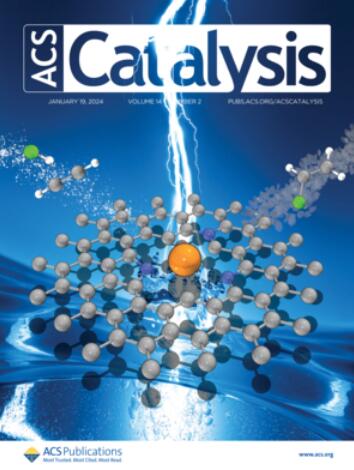含六元或七元金属环的C,N,N三齿钳型配体负载的铪配合物用于合成高性能烯烃嵌段共聚物
IF 11.3
1区 化学
Q1 CHEMISTRY, PHYSICAL
引用次数: 0
摘要
本研究提出了一系列的铪(Hf1和Hf2)和锆(Zr1和Zr2)配合物,由C,N,N三齿,钳型配体支撑,具有六元金属环与五元N,N螯合物的邻合。这些配合物在乙烯均聚反应中表现出显著的催化性能,活性高达19,500 kg(PE)·mol-1 (cat)·h-1,产生的聚乙烯分子量高达1342 kg·mol-1。有趣的是,这些配合物在乙烯/1-辛烯共聚中表现出意想不到的高选择性,掺入量低于0.3 mol %。相比之下,也合成了具有扩展七元金属环的Hf4,其活性更低。利用核磁共振和质谱对这些金属配合物的活化进行了研究,发现对于具有六元金属环的Hf2,初始的烯烃插入优先发生在Hf-CAryl键上。相比之下,Hf4中的配体在单体存在下没有被修饰,这表明与七元金属环结构相关的不同激活途径。鉴于其在共聚过程中对乙烯的高活性和选择性以及在链转移反应中的显著效率,Hf2成为与传统的C,N,N - hf配合物(py-Hf)结合生产烯烃嵌段共聚物(OBCs)中合成硬段的有希望的候选者,其高熔点(Tms高达130°C)拓宽了聚烯烃弹性体的潜在应用。本文章由计算机程序翻译,如有差异,请以英文原文为准。

Hafnium Complexes Supported by C,N,N-Tridentate, Pincer-Type Ligands Containing a Six- or Seven-Membered Metallacycle for the Synthesis of High-Performance Olefin Block Copolymers
This study presents a series of hafnium (Hf1 and Hf2) and zirconium (Zr1 and Zr2) complexes, supported by C,N,N-tridentate, pincer-type ligands, that feature a six-membered metallacycle ortho-fused to a five-membered N,N-chelate. These complexes display remarkable catalytic properties in ethylene homopolymerization, with activities as high as 19,500 kg(PE)·mol–1(cat)·h–1, producing polyethylenes with impressive molecular weights of up to 1342 kg·mol–1. Interestingly, these complexes exhibit an unexpected high selectivity for ethylene in ethylene/1-octene copolymerization, with incorporation levels lower than 0.3 mol %. For comparison, Hf4 with an expanded seven-membered metallacycle has also been synthesized and showed even lower activity. The activation of these metal complexes has been investigated using NMR and MS spectroscopy, revealing that for Hf2 with a six-membered metallacycle, the initial olefin insertion preferentially occurs into the Hf–CAryl bond. In contrast, the ligand in Hf4 is not modified in the presence of the monomer, indicating a different activation pathway associated with the seven-membered metallacyclic structure. Given its high activity and selectivity for ethylene during copolymerization and significant efficiency in chain transfer reactions, Hf2 emerges as a promising candidate for synthesizing hard segments in the production of olefin block copolymers (OBCs) in combination with the conventional C,N,N–Hf complex (py-Hf), whose high melting points (Tms reaching up to 130 °C) broaden the potential applications of polyolefin elastomers.
求助全文
通过发布文献求助,成功后即可免费获取论文全文。
去求助
来源期刊

ACS Catalysis
CHEMISTRY, PHYSICAL-
CiteScore
20.80
自引率
6.20%
发文量
1253
审稿时长
1.5 months
期刊介绍:
ACS Catalysis is an esteemed journal that publishes original research in the fields of heterogeneous catalysis, molecular catalysis, and biocatalysis. It offers broad coverage across diverse areas such as life sciences, organometallics and synthesis, photochemistry and electrochemistry, drug discovery and synthesis, materials science, environmental protection, polymer discovery and synthesis, and energy and fuels.
The scope of the journal is to showcase innovative work in various aspects of catalysis. This includes new reactions and novel synthetic approaches utilizing known catalysts, the discovery or modification of new catalysts, elucidation of catalytic mechanisms through cutting-edge investigations, practical enhancements of existing processes, as well as conceptual advances in the field. Contributions to ACS Catalysis can encompass both experimental and theoretical research focused on catalytic molecules, macromolecules, and materials that exhibit catalytic turnover.
 求助内容:
求助内容: 应助结果提醒方式:
应助结果提醒方式:


